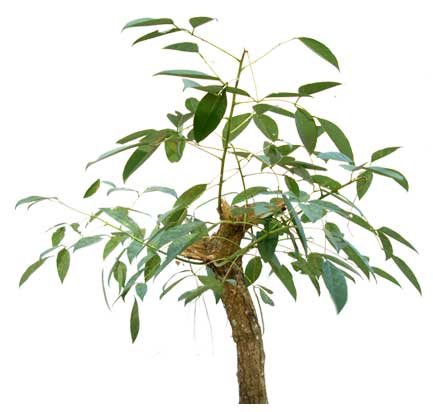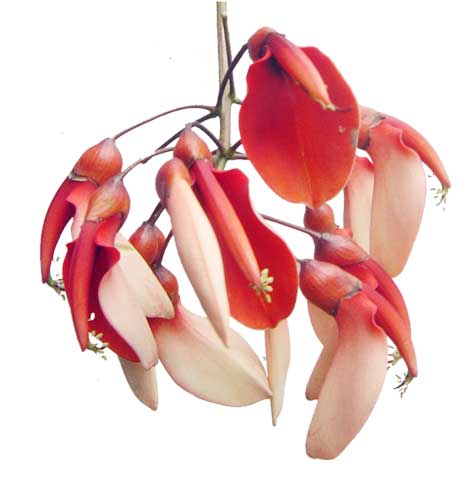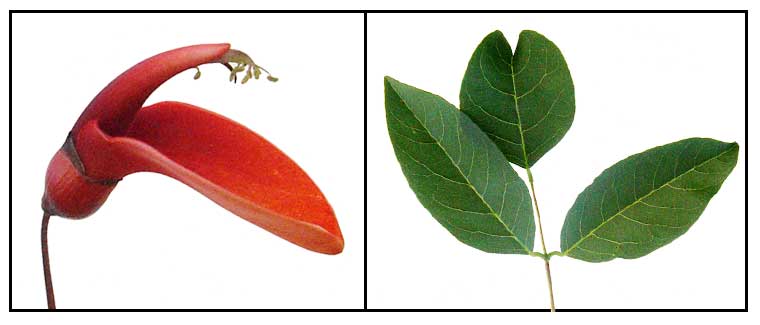|
 Gen info Gen info
- Erythrina is a genus of flowering plants in the pea family, consisting of about 130 species and distributed in tropical and subtropical regions worldwide.
= The genus name is derived from Greek erythros meaning "red" referring to the flower color of some species. (19)
- Ceibo (Erythrina crista-galli) is the national flower of Uruguay.
Botany
Coral tree is a flowering medium-sized tree, growing
to a height of 5 to 8 meters.. The trunk is woody with irregular spiny
branches. Leaves have three leaflets, smooth, alternate, up to 6 centimeters
long. Leaflets are dark green, elliptic, acute with entire margins.
Flowers are papilionate, petals 5 centimeters long, separate stamens about 1
centimeters long. Fruits are woody, elongated, cylindrical, up to 3 centimeters long.
Distribution
- Grown in Baguio gardens.
- Native to South America.
Constituents
- Contains an alkaloid
with powerful narcotic and purgative effects.
- Yields mellein, nectriapyrone, 4-hydroxymellein, scyoalone, tyrosol,
clavatol, mevinic acid, and mevalonolactone.
- Study isolated a new Erythrinan alkaloid glycoside, named erythraline-11ß-O-glucopyranoside (1), from the methanol extract of seeds of E. crista-galli. along with five known Erythrina alkaloids, erythraline (2), erythratine (3), erysodine (4), erysotrine (5), (+)-16ß-D-glucoerysopine (6), and an indole alkaloid, (-)-hypaphorine (7). (see study below) (16)
Properties
- Considered disinfectant, narcotic, purgative.
- Studies suggest anti-inflammatory, analgesic, antimicrobial, sedative, CNS depressant, antiviral properties.
Parts utilized
Bark, root.
 Uses Uses
Folkloric
In the Philippines,
not known for any medicinal use.
• In Argentina,
used as anti-inflammatory and for treatment of wounds.
• Used for its sedative properties.
• In Brazil,
several Erythrina species are used by indigenous tribes in Brazil as
insecticides, fish poison, medicine, and sleep aid.
Others
- Wood: Light, smooth, porous, and of low durability when exposed to the elements. Used for manufacture of shoe soles and heels, bowls, etc. (14)
- Dye: Flower yields a dye.
Studies
• Analgesic: Analgesic properties of extracts
and fractions from Erythrina crista-galli (Fabaceae) leaves:
The study describes the analgesic activity of extracts from Erythrina
crista-galli leaves in experimental mice models. (2)
•
Antimicrobial / Isoflavonoids: Study isolated isoflavonoids coumestrol, genistein and daidzein from
the acetone extract of E crista-galli leaves. The compounds showed antimicrobial
activity against Bacillus brevis.(9) (3)
•
Phomol / Anti-Inflammatory: The majority of endophytes isolated from different collections of E
crista-galli are species of the genus Phomopsis. Phomol,
a novel antibiotic, was isolated from an endophytic fungi from the medicinal
plant E crista-galli. (4)
• Curarizing Effect: Study evaluated the effect of alcoholic and aqueous extracts of E. crista-galli in cats anesthetized with dial. Extracts produced depression of responses of effectors innervated by cholinergic nerves when the nerves are stimulated by injected by acetylcholine. (7)
• Biosynthesis of Erythrina Alkaloids: Study evaluated the Erythrina alkaloid formation in E. crista-galli. (S)-coclaurine as well as (S)-norreticuline were metabolized to erythraline and erythrinine, suggesting a coclaurine-norreticuline pathway. (8)
• Pterocarpan Compounds Synthesis / Anti-Malarial: Study yielded sandwicensin (1), a major compound from the stem bark of Erythrina crista galli. Compounds 2 (3-acetyl sandwicensin) and compound 3 (2,7,-dibromo sandwicensin) were synthesized by acetylation and bromination of sandwicensin. Compound 1 from the stem bark and synthesis compounds 2 and 3 showed activity against Plasmodium falcifarum. (10)
• Phenolic Compounds / Anti-Malarial / Antioxidant: Study isolated three phenolic compounds from the stem bark of E. crista-galli: phaseollidin (1), sandwicensin (2), and lonchocarpol A (3). Evaluation for antimalarial activity against P. falcifarum showed IC50 of 1.66, 183, and 1.69 µg/mL, respectively. Antioxidant activity against DPPH showed IC50 of 209.4, 305.6 and 1115.7 µM, respectively. (11)
• Lectin / Matrix for Human Pluripotent Stem Cells: Study reports on an Erythrina cristagalli lectin (agglutinin) (ECA) matrix that supported the undifferentiated growth and significantly increased the plating efficiency of both hESC (human embryonic stem cells) and human induced pluripotent stem cells when used in conjunction with pinacidil. Findings suggest ECA is a potent simple defined matrix for human pluripotent stem cells. (12)
• Sedative / CNS Depressant / Leaves: Study evaluated aqueous and organic extracts of leaves for sedative properties using Hippocratic screening test, spontaneous locomotor activity and potentiation of pentobarbital sleeping time test. Twp extracts showed statistically significant CNS depression. Two fractions, both free of alkaloids, showed preliminary sedative properties. (13)
• Antimicrobial Isoflavonoids / Young Twigs: Study isolated isoflavonoids coumestrol, genistein, and daidzein from the acetone extract of E. crista-galli young twigs infected with Phomopsis sp. The compounds showed antimicrobial activity against Bacillus brevis. (15)
• Erythrinan Alkaloid Glycoside / Antiviral against TMV / Seeds: Study isolated a new Erythrinan alkaloid glycoside, named erythraline-11ß-O-glucopyranoside, from the methanol extract of seeds of E. crista-galli. along with five known Erythrina alkaloids and an indole alkaloid. All the isolated alkaloids showed noticeable inhibition of replication of TMV (tobacco mosaic virus) in a relatively higher concentration compared with the positive control agent. (see constituents above) (16)
• In the News: Making Electricity from Flowers and Fruits: Chemist Maria Fernanda Cerda uses natural dyes from Uruguay's indigenous flora to build solar cells. Plant pigments anthocyanins absorb light and turn into energy to fuel photosynthesis and harness the power to generate electricity. The technology was originally developed in Switzerland, In the study, the chemist is using indigenous plants from Uruguay, including its national flower the ceibo (Erythrina - crista-galli). It involves purifying the ceibo extract, extracting the bright red dyes, and using a solar stimulator to convert the plant dye into electricity.(The chemist seeks funding to continue her work.) (17)
• Natural Dye for Plant Histology Staining/ Poor Stability: Study evaluated the potential of Erythrina crista-galli flower extract as natural dye using parameters of quality and stability. Extraction was done using the maceration method. A 70% concentration produced a dye of the highest quality. However, on second observation, the color of the preparation deteriorated suggesting suboptimal stability and can not be recommended for natural staining. (18)
Availability
Wildcrafted.
|



 Gen info
Gen info Uses
Uses

